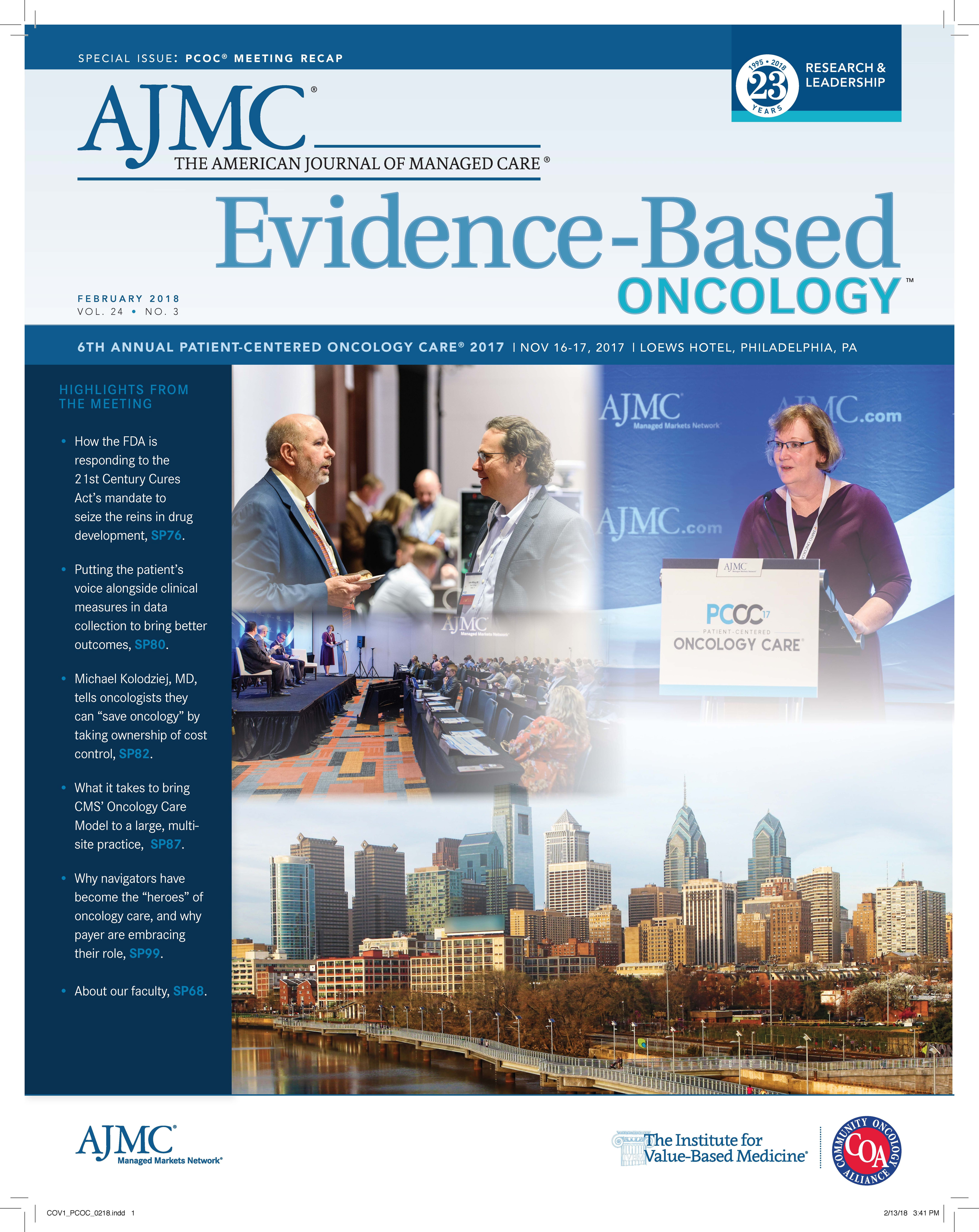Publication
Article
Evidence-Based Oncology
FDA Moves to Era of Active Participant in Drug Development
Author(s):
Coverage of regulatory changes from Patient-Centered Oncology Care, November 16-17, 2017.
The headlines of the 21st century Cures Act said it provided $6.4 billion for scientific research for cancer, Alzheimer disease, and opioid addiction, as well as steps to speed drug development, including new approval pathways for certain devices and biologics.1,2
But beyond that, said the FDA’s Frank Weichold, MD, PhD, of the Office of the Commissioner and the Office of the Chief Scientist, the Cures Act brings a new way of thinking about the agency’s role: For decades, most regulation was a reaction to some tragedy or weakness in existing rules. Cures ushers in an era of the FDA as a partner in drug development, Weichold said, as he kicked off Patient-Centered Oncology Care®, held November 16 and 17, 2017, in Philadelphia, Pennsylvania.
Speaking before a gathering of The American Journal of Managed Care®, Weichold explained how the FDA has created a culture of regulatory science and that the Cures Act brings the next step. Regulatory science is not “an attempt to regulate science,” he said, but an effort to guarantee that rulemaking for drugs, foods, and consumer products under the agency’s purview follows a process that ensures safety and quality under standards that are consistent and not based on unexpected whims. The less evidence there is, the more individual judgment creeps into the process, Weichold explained.
With the Cures Act, drug development will be simultaneously more evidence driven and patient centered. “It makes the FDA an active participant in drug development, and it requires us to focus more on patient-focused drug development using novel innovative trial designs, applying real-world evidence, and create drug development tools to speed this up,” Weichold said. Clinical trials as we know them are “essentially disconnected from the real word,” he noted, and that sometimes results in real-world outcomes that don’t match what happened in studies—to say nothing of the high research costs.
FDA Commissioner Scott Gottlieb, MD, supports the use of computer modeling in the drug development process, Weichold said, as well as adaptive and novel trial designs that are already in use. But this requires good data—and Weichold said there’s much to be done to get data out of silos and to encourage sharing to create algorithms that can speed medical decisions, with fewer errors.
“We are on an inflection point when it comes to the reductionist position and thinking in a holistic world, and what’s between is a lot of data,” he said.
Knowledge and data sharing isn’t where it should be, Weichold said, and “we need better communication, and we need better transparency opportunities” that are not a burden for investigators. Yet he said every person in the room could likely think of an example of a hospital administrator or rule maker who prevented data sharing.
The 21st Century Cures Act calls on regulators to “get engaged,” Weichold said, and facilitate sharing by creating frameworks to make it happen. Because when it happens, patients will benefit, he said.
“Essentially, to enter the right data once and use it many times is something that we have to accomplish,” Weichold said. Regulators can help health systems address privacy and safety concerns, but “we have to change the culture,” he added.
He pointed out examples from the FDA’s Oncology Center of Excellence, which collaborated with the Harvard Business School to develop master trial protocols; he also discussed the I-SPY 2 breast cancer trial, which follows an adaptive design that takes the response times from patients as they move through the trial to make treatment decisions for future patients.3
Data sharing is key in developing better biomarkers, Weichold said, which the I-SPY trials and other analyses have shown can be used as surrogate end points, to help bring drugs to market fast and identify positive responders. He cited work by Laura Esserman, MD, MBA, at the University of California at San Francisco in the I-SPY trials, which has shown how trials can work with real-time feedback.
Data and technology alone are not enough, however. “We have most of the things that it takes to have a continuous collab- orative and transparent system, including data exchange, data liberation, [and] data markets, if you want to call it that way,” he said. “But what we need is to build trust and build relationships, and as such, it all hinges on the people—people who are also depending on the FDA.”
Who are the final collaborators? Patients. “We need to include patients in a different way—make them co-researchers, codevelopers—and leverage the tools that we have in our advanced age of technology.”
“And with that,” he concluded, “we will have better outcomes, better performance, and, perhaps, happier people.”References:
1. 21st Century Cures Act. FDA website. fda.gov/RegulatoryInformation/LawsEnforcedbyFDA/SignificantAmendmentstotheFDCAct/21stCenturyCuresAct/default.htm. Updated September 14, 2017.
2. DeBonis M. Congress passes 21st Century Cures Act, boosting research and easing drug approvals. Washington Post. December 7, 2016. washingtonpost.com/news/powerpost/ wp/2016/12/07/congress-passes-21st-century-cures-act-boosting-research-and-easing- drug-approvals/?utm_term=.aade676a9585. Accessed January 4, 2018.
3. The I-SPY trials. ispytrials.org/home. Accessed January 4, 2018.







